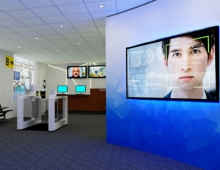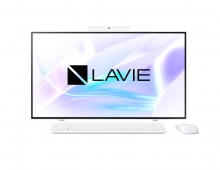
NEC's panel-sized scan driver achieves 768 outputs for XGA TFT-LCDs
NEC announced the development of a panel-sized scan driver, said to be the world's first system-on-glass (SoG), large-scale integrated (LSI) chip to achieve 768 outputs for extended graphics array, thin-film transistor, liquid crystal displays (XGA TFT-LCD).
The new driver is expected to realize lower manufacturing costs and smaller module volume for
medium to large TFT-LCDs.
>
Panel-sized drivers possess a length approximate to that of LCD width or height, have identical outputs for scan and column lines, and do not require tape-carrier packages (TCP) or printed circuit boards (PCB) in assembly. The drivers are silicon-on-insulator (SoI) devices made on a glass substrate with a complementary metal-oxide-semiconductor (CMOS) TFT circuit. Taking into account the floating-body effect, NEC has fabricated a 189mm-long scan driver with 768 outputs for XGA TFT-LCDs using NEC's low-voltage (5V) and high-voltage (15V, 40V) CMOS TFTs.
The features of the prototype panel-sized scan driver are as follows:
1) With a length of 189mm and a width of 1.41mm, the driver is narrow enough to be assembled at the edge of an LCD;
2) Although conventional modules need to be assembled with more than 10 parts, panel-sized driver modules only require that the drivers be assembled directly on the LCD panel. In addition, they do not require PCBs or TCPs. As a result, the assembly time for panel-sized drivers is significantly accelerated, as there are only three parts to assemble;
3) Due to a new level-shifter circuit, which greatly reduces unexpected delays caused by the floating-body effect of TFTs, stable operations can be achieved in wide duty/voltage ranges.
Panel-sized drivers are fabricated on a large, rectangular, glass substrate with SoG technology and possess identical thermal expansion coefficient to LCD glasses. They also contain functions for TCPs and PCBs. As a result, SoG panel-sized drivers can be fabricated at a reasonable cost with superior assembly reliability.
>
Panel-sized drivers possess a length approximate to that of LCD width or height, have identical outputs for scan and column lines, and do not require tape-carrier packages (TCP) or printed circuit boards (PCB) in assembly. The drivers are silicon-on-insulator (SoI) devices made on a glass substrate with a complementary metal-oxide-semiconductor (CMOS) TFT circuit. Taking into account the floating-body effect, NEC has fabricated a 189mm-long scan driver with 768 outputs for XGA TFT-LCDs using NEC's low-voltage (5V) and high-voltage (15V, 40V) CMOS TFTs.
The features of the prototype panel-sized scan driver are as follows:
1) With a length of 189mm and a width of 1.41mm, the driver is narrow enough to be assembled at the edge of an LCD;
2) Although conventional modules need to be assembled with more than 10 parts, panel-sized driver modules only require that the drivers be assembled directly on the LCD panel. In addition, they do not require PCBs or TCPs. As a result, the assembly time for panel-sized drivers is significantly accelerated, as there are only three parts to assemble;
3) Due to a new level-shifter circuit, which greatly reduces unexpected delays caused by the floating-body effect of TFTs, stable operations can be achieved in wide duty/voltage ranges.
Panel-sized drivers are fabricated on a large, rectangular, glass substrate with SoG technology and possess identical thermal expansion coefficient to LCD glasses. They also contain functions for TCPs and PCBs. As a result, SoG panel-sized drivers can be fabricated at a reasonable cost with superior assembly reliability.





















